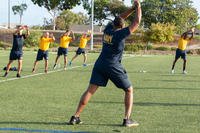When working out to reach a tactical fitness goal, you may find that you start the process with a few strengths from your own athletic history. However, you also may have to face a few weaknesses.
For instance, a football player focusing on strength, power, speed and agility may not be able to maintain a fast running pace for longer distances (timed runs), swim (technique and endurance) and even score well in higher-repetition calisthenics testing (muscle stamina or strength endurance).
Depending on the job you want and the journey through basic training, advanced training or selection, you may need to become a more well-rounded athlete. We call that the tactical athlete.
In the world of tactical fitness, you do not need to be great at a particular thing, as you did in competitive athletics, but you need to be good at everything.
Here is a question from a former athlete preparing for an Army career:
Stew, I have noticed the Tactical Fitness periodization system that you have been doing for over 20 years now. I get it, and it makes sense coming from my powerlifting background. However, the seasons are typically quarters (12-13 weeks), and that is a long time to focus on one element. Are these seasons of training written in stone or can you add some flexibility to them? Just curious because I need to focus on endurance and muscle stamina but also want to maintain a respectable level of strength. Any suggestions? -- Sam B.
Sam, thanks for the note. Like I always have said, I have a way to train -- not the way to train, but yes, you can supplement some lifts into the cardio and calisthenics months (spring and summer), even though there is a mix of weights in the spring cycle as you taper from the winter lift cycle.
My suggestion is to start with a spring cycle, where there is a mix of weights that evolves into lighter lifts and more calisthenics repetitions. Add in a running program with a logical progression that extends through the summer. The summer is a long time to do calisthenics and running, but you also can add in load-bearing activities as you progress with your running.
Rucking should be a part of your preparation, especially as your journey will take you through Army Ranger training, where longer runs and rucks are a daily event.
As a former powerlifting athlete and football player myself, I actually took more than a year and focused on triathlon training and calisthenics with nearly no weights as I became a better Navy SEAL candidate. I get that you will miss the weight room, but you can add in a short supplemental weight training day a few days a week and will not see any reduction in performance in your running and high-rep muscle stamina if you follow a few rules:
1. Do your upper-body lift supplement on days you do pull-ups, push-ups and other upper-body calisthenics.
2. Do your lower-body lift supplement (squats and/or deadlifts, hang cleans, power cleans) on days you do calisthenics or weight vest squats and lunges.
3. For 1 and 2, it is best to keep the splits together as you may find that, if you do not focus on proper arrangement, you will wind up doing a high-volume leg day, followed by a leg lift day, followed by a long run or ruck. Recovery matters when you lift weights, as well as when you do higher-volume calisthenics.
4. I would avoid heavy weight training when doing lifts during the spring and summer phases, as the goal of this phase is to focus on running and rucking endurance, timed-run goal mile pace speed and muscle stamina. There is a place for heavier lifting, and that is in the fall and winter phases of the seasonal tactical fitness periodization system. We typically keep the lifts to body weight or 1.5x body weight, to give a general idea of what is "heavy."
5. If you add a cardio event because you need to focus more on endurance, consider a non-impact option such as swimming, biking, rowing or elliptical, especially if you are feeling the impact of running and rucking miles. Most people who are learning swimming will need to add near-daily swim workouts to learn the new skill and get into swimming shape, no matter what type of land athlete you are.
It takes time to transition from a powerlifting background since the running and rucking and higher reps work a different energy system. You may find it fun and challenging, as the workouts add a wide variety of exercises, goal times to meet and opportunities for growth -- just in other areas than you're used to. You may find you actually like some of the cardio or calisthenics events as you start to see improvement.
Once you have turned your weaknesses into a strength, you will find the 12-week cycle is not too long to help you focus on certain elements of fitness and actually will not be long enough to decrease your strengths in any other elements. If you feel you need to add a supplemental lift, run, swim or ruck, there is always room to do so if you follow the rules above.
Stew Smith is a former Navy SEAL and fitness author certified as a Strength and Conditioning Specialist (CSCS) with the National Strength and Conditioning Association. Visit his Fitness eBook store if you're looking to start a workout program to create a healthy lifestyle. Send your fitness questions to stew@stewsmith.com.
Want to Learn More About Military Life?
Whether you're thinking of joining the military, looking for fitness and basic training tips, or keeping up with military life and benefits, Military.com has you covered. Subscribe to Military.com to have military news, updates and resources delivered directly to your inbox.




















